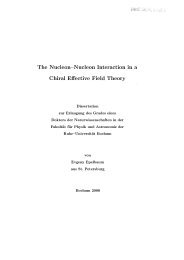t Hooft mechanism of confinement or dual Meissner effect
t Hooft mechanism of confinement or dual Meissner effect
t Hooft mechanism of confinement or dual Meissner effect
You also want an ePaper? Increase the reach of your titles
YUMPU automatically turns print PDFs into web optimized ePapers that Google loves.
x = rm W , κ = λ e .<br />
E<br />
= Lv 2 ∫<br />
d 2 x<br />
[<br />
B<br />
′2<br />
2 + ∣ ∣(∂ i − ieA ′ i )φ′∣ ∣ 2 + κ 2 (φ ′ 2 − 1) 2 ]<br />
,<br />
v<strong>or</strong>tex transverse size ρ 0 ∼ 1 √ κ<br />
.<br />
String tension = σ = energy / length <strong>of</strong> the tube = v 2 [ O(1) + O<br />
(<br />
mH<br />
m W<br />
)].<br />
Londons’ limit: m H → ∞ =⇒ infinite-energy v<strong>or</strong>tex<br />
Bogomolny–Prasad–Sommerfeld limit: m H → 0.<br />
type-I superconduct<strong>or</strong>: (m H > m W ): no v<strong>or</strong>tices<br />
type-II superconduct<strong>or</strong>: (m H < m W ): yes<br />
One needs an analog <strong>of</strong> type II superconduct<strong>or</strong> with magnetic monopoles condensed.<br />
Confinement in the 3d Ge<strong>or</strong>gi–Glashow model D. Diakonov, L-12












